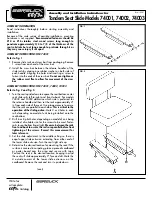
Rear Axle Bushing Service
(2WD Units)
The rear axle must be held in place snugly by the axle
pin. Excessive movement of the axle, which is charac-
terized by erratic steering, usually indicates worn bush-
ings. To correct the problem, replace the bushings.
1. Disconnect the hydraulic hoses from the steering
cylinder. Put caps or plugs on all the fittings and hoses
to prevent contamination.
NOTE: To ease reassembly, tag each of the hoses to
show their correct position on the steering cylinder.
2. Remove the nut (Fig. 16, Item 9) from the end of the
rear axle pin. Remove the two (2) cap screws (Item 2)
securing the axle pin to the frame.
3. Jack up the frame (just ahead of the rear wheels) until
pressure is taken off the axle pin. Support the machine
with jack stands to prevent it from falling.
4. Pull the axle pin out. This will release the rear axle
and washer(s) from the frame. Carefully pull the entire
axle and wheel assembly out from under the machine.
NOTE: A varying number of washers (Item 45) may have
been installed between the axle pivot tube and frame
during manufacture. Make sure the same number of
washers are installed during reassembly.
5. Use a drift punch and hammer to drive both bushings
(Item 4) out of the axle pivot tube. Clean the inside of
the axle pivot tube to remove dirt and foreign material.
6. Apply grease to the inside and outside of the new
bushing. Use an arbor press to install the bushings into
the top and bottom of the axle pivot tube. Bushings must
be flush with the axle tube.
7. Wipe the rear axle pin with a rag to remove dirt and
grease. Inspect the pin for wear or damage and replace
as necessary.
8. Mount the axle to the frame with the axle pin. The
washer(s) (Item 45) must be positioned between the
front end of the pivot tube and the frame (see the NOTE
after step 4). Secure the axle pin in place with the two
(2) cap screws (Item 2). Install the washer (Item 8) and
nut (Item 9).
9. Remove the jackstands and lower the machine to the
floor.
10. Install the hydraulic hoses to the steering cylinder.
11. Lubricate the rear axle bushings through the grease
fitting on the rear axle.
Steering Pivot Bushing Service
(2WD Units)
The steering pivot (Fig. 16, Item 38) must fit snugly onto
the mounting pin. Excessive movement of the steering
pivot may indicate worn bushings or tie rod ball joints.
1. Remove the lock nut (Item 37) and cap screw
(Item 11) securing the steering cylinder rod end to the
steering pivot (Fig. 16).
2. Remove two (2) nuts (Item 43) to disconnect the tie
rod end (Item 39) from the spindle arm (Item 1, 33).
Inspect all tie rod end ball joints for wear or damage and
replace as necessary.
3. Remove the retaining ring (Item 12), washer (Item 17)
and thrust washer (Item 18). Slide the steering pivot off
of the mounting pin on the bottom of the axle.
4. Use a drift punch and hammer to drive both bushings
(Item 41) out of the steering pivot. Clean the inside of
the steering pivot tube to remove dirt and foreign mate-
rial. Also clean the mounting pin on the bottom of the
rear axle.
5. Apply grease to the inside and outside of the new
bushings. Use an arbor press to install the bushings into
the top and bottom of the steering pivot tube. Bushings
must be flush with the end of the tube.
6. Slide the steering pivot onto the mounting pin. Secure
the plate in place with the thrust washer, washer and
retaining ring.
®
Repairs
Page 8 - 12
Groundsmaster
300 Series
Summary of Contents for Groundsmaster 328-D
Page 2: ......
Page 12: ...Torque Specifications Page 2 4 Rev A Groundsmaster 300 Series ...
Page 44: ...Troubleshooting Page 4 16 Groundsmaster 300 Series ...
Page 45: ...Groundsmaster 300 Series Page 4 17 Troubleshooting ...
Page 171: ...Groundsmaster 300 Series Page 6 25 Testing ...
Page 220: ...Repairs Page 7 24 Groundsmaster 300 Series ...
Page 320: ...Troubleshooting Troubleshooting Page 11 4 Groundsmaster 300 Series ...
Page 348: ...Troubleshooting Troubleshooting Page 12 4 Groundsmaster 300 Series ...
Page 379: ...Troubleshooting Groundsmaster 300 Series Page 13 3 Troubleshooting ...
Page 400: ...This page is blank ...
Page 401: ...This page is blank ...
















































